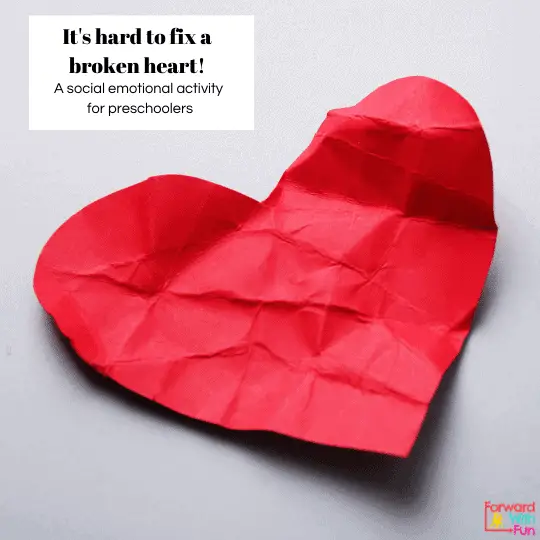
Welcome to the all-inclusive list of social emotional activities for preschoolers. These twenty super helpful activities help young children develop their sense of self as well as interpersonal skills.
Social emotional learning is nonacademic learning that focuses on a person's understanding of themselves and their feelings as well as their relationships with other people.
Studies have shown that kids who have strong social emotional skills in kindergarten have better lifelong outcomes in education, employment, and mental health.
Besides better outcomes in later life, teaching social emotional skills to 3 and 4 year old's is much easier due to the higher adult to children ratios in preschool. And teaching them skills like kindness, mindfulness, and understanding feelings will help them get their needs met and grow positive relationships with others in school and other settings!
*As an amazon associate I may get a small commission from any purchases you make using links in this post. Thanks!
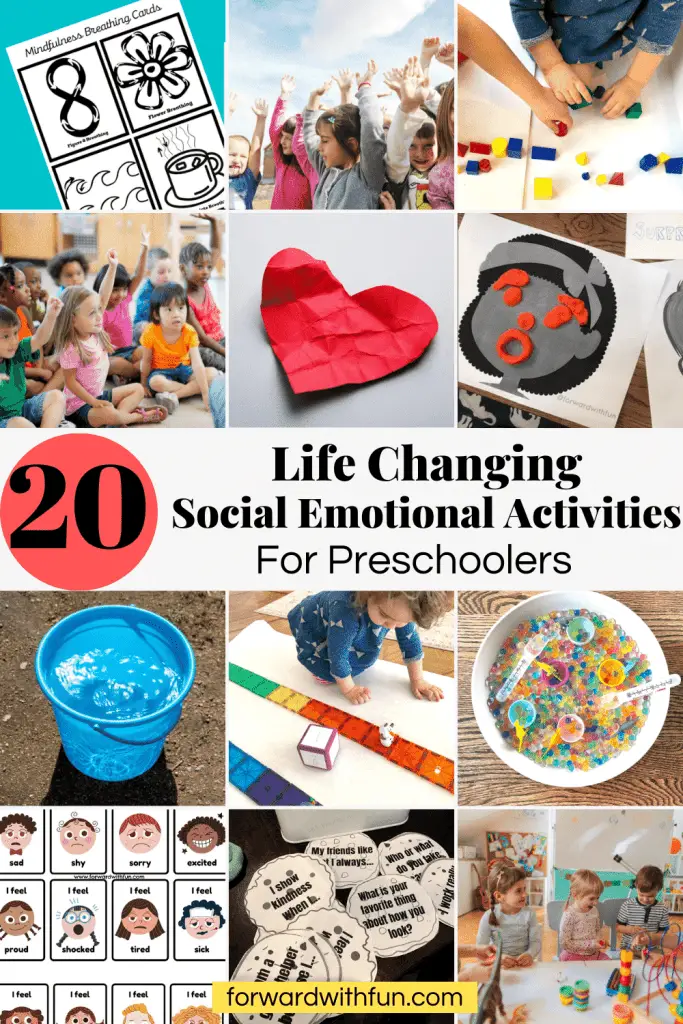
To help make sense of this all-inclusive list, I'm separating these activities into ones that develop sense of self and ones that develop interpersonal skills.
The sense of self activities help develop preschoolers' abilities to
The interpersonal skill building activities will focus on kids' abilities to
Studies from Yale have found that Kids who understand their own feelings in turn build stronger relationships with others. By teaching kids to recognize, label, and understand feelings kids can better express their needs without frustration.
Click the picture to grab your free playdough mats and begin learning about feelings right now!
Think Pixar's Inside Out but with more feelings. Build kids' vocabulary of emotion words by writing a bunch and putting them into a hat. Have children take turns picking a feeling word, have an adult read it to them, and then act it out for the other people to guess! Click the picture to snag these cards for free!
Sometimes it is difficult for preschoolers to figure out how to deal with their emotions, but it becomes easier when their situation relates to a story they know.
Some of my favorite feelings books that build self understanding are:

The last one in that list is called a social story, where children read about a scenario that is relatable to them and find out how the character deals with it. Social stories are helpful social emotional teaching tools that help make the big abstract ideas of emotions a lot more understandable for young children.
Kids who practice mindfulness breathing have a great tool in their toolbox when they feel overwhelmed or frustrated. Mindfulness is all about being aware of yourself in your environment.
These fun breathing cards make deep breaths fun by turning them into hot cocoa or flowers! Print them out and laminate them to pull out for your kids or students to use during the day. Don't forget to follow the arrows with your fingers as you breathe in and out. Visit the shop to purchase.
Mindfulness is all about being present and really feeling the world around you without distraction. One of the best ways to do this is to use our 5 senses. Have your child lie down and then ask them to name:
Try this grounding technique to help center yourself and your child. It's a great way to help busy minds rest or get ready for bed.
I created confidence cookies as part of The Fun Club, where kids aged 4-5 get sent 5 weekly activities that teach them reading, math, and social skills.
Kids and adults practice positive self talk, building their confidence and self-esteem.
Each day during dinner, I play "Rose and Thorn" with my kids. This is a time to reflect upon our day where we share our favorite and least favorite part of the day.
During this time, kids are able to share about their day in a way that normalizes the "bad" and the "good." Not everything is always going to be positive, and by creating this time together, children know they'll always have a designated time to sort through the important things going on in their lives.
My daughter has had this up in her room for 2 years and whenever she gets upset, she goes to look at her calm map for something that brings her comfort. Having a calm map has been immeasurably helpful.
Since my daughter came up with the list for each category, she has a long list of items that she has self declared to help her feel calm. Such a relief to me! Click the photo to download yours for FREE!
The trend on Instagram lately has been sensory play, and you know why? Because it is soothing, calming, and helps preschoolers regulate their needs better. In fact, sensory bins are the perfect social emotional activity for preschoolers. They can be a go-to as a calm down activity when you need one!
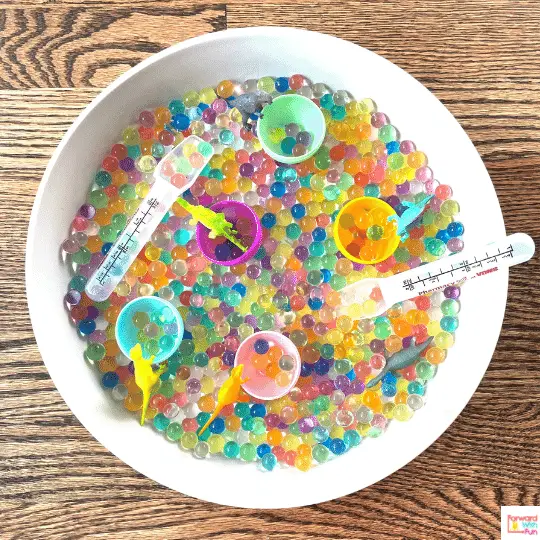
If you're looking for some inspiration, check out this post on 50+ sensory bin fillers to use with preschoolers.
Interpersonal skills are also known as social skills and help develop relationships with others.
This one might be a no brainer, but did you know playing board games with preschoolers is a great way to build social skills. Here are the skills playing board games build:
My favorite board game to play with my preschooler is Candyland, but you can also quickly make your own like THIS!
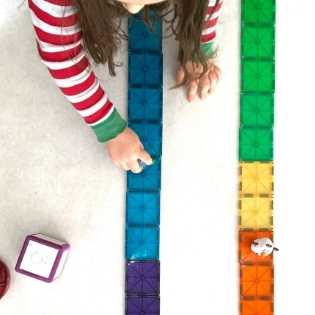
Preschoolers love building, so bust out whatever blocks or building items you have for this social emotional activity that takes no time to prep and builds teamwork, turn taking, and cooperation.
Pair off children in teams of 2 or more and challenge them to work together to build a tower that is X blocks high. Watch them work together, take turns, and feel the pride and success of reaching their goals!
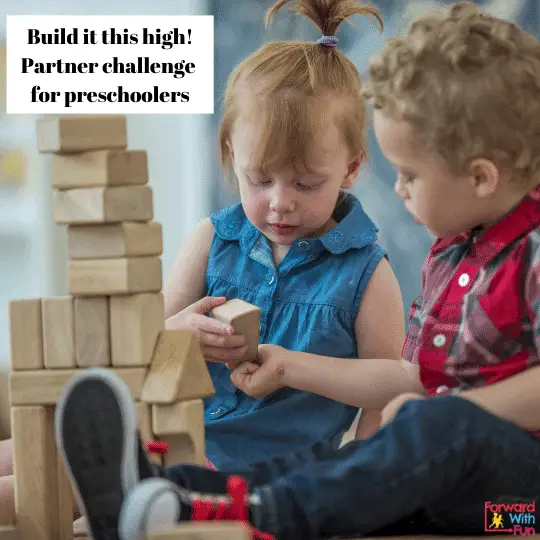
Let's practice one of the hardest preschool skills...sharing! All you'll need is a 10 of one kind of item. It could be marshmallows, blocks, squishy toys, anything. Talk about why sharing is important: it's fair, makes people feel good, it's kind.
Practice dividing up the small number of items, by repeating "one for you, one for me, one for you, one for me" and placing one item at a time in front of each person. If there is an odd number, problem solve. What can we do? Should we cut it in half? Should we place it back in the box? Preschoolers can come up with some really creative solutions and take pride in being "fair."
Hooray for a gross-motor social emotional activity! If you've got wiggly preschoolers, this one is going to be a hit. Have everyone stand in a circle or on a specific spot on the rug, if you're in a classroom. If you're at home, make a few designated "spots" for everyone playing.
Have one person be the leader for the first round and have that person call out, "Switch if you like _________," or "Switch if you have _______." Model this for the kids, and then they can take turns being the leader.
When kids learn about their similarities, they learn that we all have more in common than we do different. Kids will often build a friendship over something the other child has in common with them, so this can be a great jumping board. "Hey you also love PJ Masks!?"
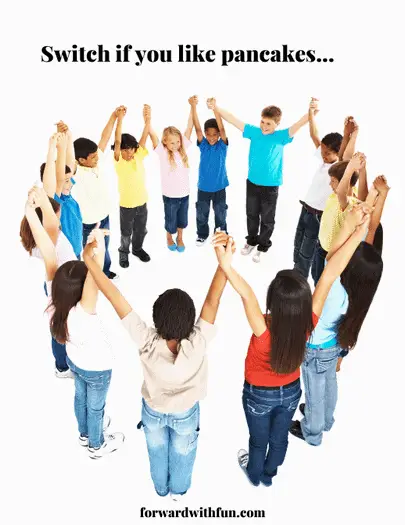
Preschoolers often really connect with music! I love to start the day with a Hello Song, where kids go around greeting one another practicing their chosen way to say "Hello!"
Some suggestions I give to students are to try saying hello in multiple ways: a wave, high five, handshake, saying hello to the kids in the room.
Some of my favorite hello songs are "Hello, How Are You?" by Dr. Jean Feldman and "Hello Song" by The Kiboomers.
There are SO many Hello songs out there, if you just search that phrase!
Sometimes, kids need a little nudge to talk to new people in their class. That's where "Find your partner" comes in. For this game, give kids a specific colored item and have them find someone with that same color then freeze, raising their item up in the air.
I've seen this game done with Magna-tiles, where kids first look for someone with the same color and then someone with the same shape. The game is complete when everyone finds their partner, so make sure you have a partner for each kid!
Brainstorm ideas of kindnesses. We came up with saying thank you, sharing with a sibling, and cleaning up a big mess.
Compare those 3 kind actions to the small, medium, and large objects.
Name the kindness that goes with the object and then let your child drop the kindness item into the bowl with water.
Observe what happens- the ripples and movement in the water is like kindness moving out into the world and touching the lives of others who are more likely to make kind choices. We will call these kindness ripples.
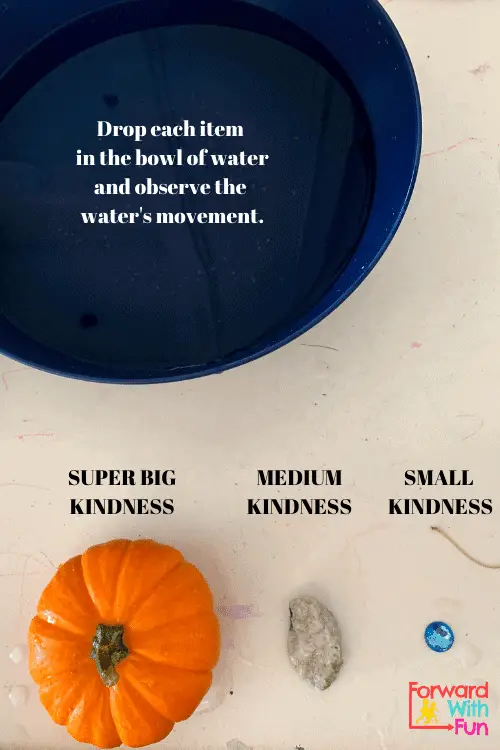
So this activity might be my favorite, because I wrote my Masters Degree thesis on it! In my classroom from 2010-2011 I did research on compliment giving as a way to build confidence in children but also as a way to build friendships between children.
Here's what you do:
Go around in a circle taking turns saying something nice about others in the circle. At first preschoolers might give compliments like "I like her," or "I like his pants."
Over time, their compliments often evolve to be more based on actions and feelings like "I like to play with James because she is good at sharing," or "Tamra is very good at writing her name." It is important for the adult to model compliment giving as well.
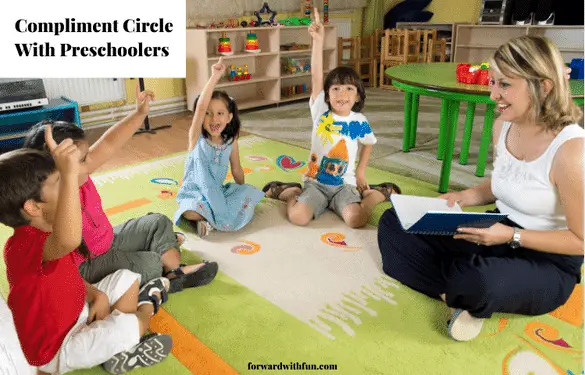
Make a kindness calendar for the week with random acts of kindness for Monday-Sunday. Each day read the act of kindness for that day and try to complete it by nighttime. The next day, discuss, how did that feel for you? For the other person?
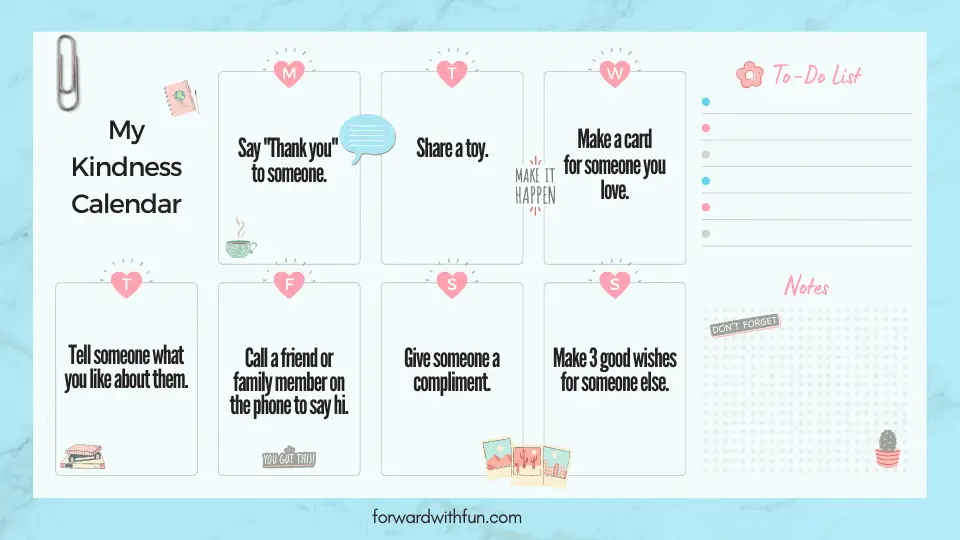
I read this to my own children and students every single year. I cannot recommend this book enough, because it helps children very concretely understand how their words effect others in both positive and negative ways. The language used in this story is something that we come back to over and over again with my now 3 and 6 year old.

"That hurt my feelings!" What a very abstract concept for young children. In this activity, children can see how their words can wrinkle a heart and how even when we apologize, hurtful words can stick.
Cut out a heart shape from a piece of paper. Take turns saying "mean things" to the heart. Each time something mean is said, make a crease or fold onto the heart until it's covered with folds and creases. Then try to smooth out the heart to be back to what it was before.
Can it be done? Even when we say sorry for harsh things said, they can still hurt out hearts, so be careful with your words!
